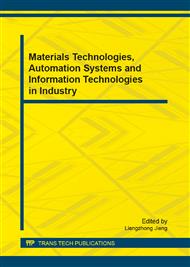[1]
E. -S.Z. El-Ashtoukhy., N.K. Amin. and O. Abdelwahab. (2008). Removal of lead (II) and copper (II) from aqueous solution using pomegranate peel as new adsorbent. Desalination. 223, 162-173.
DOI: 10.1016/j.desal.2007.01.206
Google Scholar
[2]
T. V , Ramachandra., N. Ahalya., and R. D Kanamadi. (2008). Biosorption : Techniques and Mechanisms. CES Technical Report 110.
Google Scholar
[3]
K. Vijayaraghavan. and Y-S Yun. (2008). Bacterial biosorbents and biosorption. Biotechnology Advances. 26, 266–291.
DOI: 10.1016/j.biotechadv.2008.02.002
Google Scholar
[4]
H. K. Alluri., S. R. Ronda., S. S Vijaya., S. B Bondili., V. Suryanarayana. and P. Venkateshwar. (2007). Biosorption: An eco-friendly alternative for heavy metal removal. African Journal of Biotechnology Vol. 6 (25), 2924-2931.
DOI: 10.5897/ajb2007.000-2461
Google Scholar
[5]
A. Ozer., H.S. Altundogan., M. Erdem and F , Tunmen. (1997). A study on the Cr(VI) removal from aqueous solutions by steel wool. Environmental Polution. 97, 107-112.
DOI: 10.1016/s0269-7491(97)00065-1
Google Scholar
[6]
G. M Ayoub., A. Hamzeh, L. and Semerjian. (2011). Post treatment of tannery wastewater using lime or bittern coagulation and activated carbon adsorption. Desalination. 273, 359-365.
DOI: 10.1016/j.desal.2011.01.045
Google Scholar
[7]
S. Rengaraj., C. K. Joo., K. Younghun. and Y. Jongheop. (2003). Kinetics of removal of chromium from water and electronic process wastewater by ion exchange resins: 1200H, 1500H and IRN97H. Journal of Hazardous Materials. B102, 257–275.
DOI: 10.1016/s0304-3894(03)00209-7
Google Scholar
[8]
M. Mohsen-Nia., P. Montazeri. and H. Modarress. (2007). Removal of Cu2+ and Ni2+ from wastewater with chelating agent and reverse osmosis. Desalination. 143, 276-281.
DOI: 10.1016/j.desal.2006.01.043
Google Scholar
[9]
Z.G. Guiragossian., G.A. Martoyan., S.G. Injeyan., S.G. Tonikyan. and G.G. Nalbandyan. (2003). The extraction of heavy metals by means of a new electrolytic method. W. M'03 Conference, Tucson AZ.
Google Scholar
[10]
G. H. Pino., L. M. Souzo de Mesquita., M. L. Torem. and G. A. S. Pinto. (2006). Biosorption of cadmium by green coconut shell powder. Minerals Engineering. 19, 380-287.
DOI: 10.1016/j.mineng.2005.12.003
Google Scholar
[11]
H. Michael. and I. Ayebaemi. (2005). Effect of metal ion concentration on the biosorption of Pb2+ and Cd2+ by Caladium bicolour (wild cocoyam). African Journal of Biotechology. 4, 191-196.
Google Scholar
[12]
B. Volesky (1990). Biosorption of Heavy Metals. CRC Press, Boca Raton, USA, 396.
Google Scholar
[13]
B Volesky. and Z. R. Holant. (1995). Biosorption of Heavy Metals. Biotechnol Prog. 11, 235-250.
DOI: 10.1021/bp00033a001
Google Scholar
[14]
M. Tsezos., E. Remoundaki. and A. Hatzikioseyian. Biosorption - principles and applications for metal immobilization from waste-water streams. National Technical University of Athens (NTUA).
Google Scholar
[15]
N. Ahalya., T.V. Ramachandra. and R.D. Kanamadi. (2003). Biosorption of Heavy Metals. Research Journal Of Chemistry And Environment. Vol 7(4).
Google Scholar
[16]
R. Zein., R. Suhaili., F. Earnestly., Indrawati. and E. Munaf. (2010). Removal of Pb(II), Cd(II) and Co(II) from aqueous solution using Garcinia mangostana L. fruit shell. Journal of Hazardous Materials. 181, 52-56.
DOI: 10.1016/j.jhazmat.2010.04.076
Google Scholar
[17]
Z. Sag Y. and T. Kutsal. (1992). The biosorption of copper by C. vulgaris and Z. ramigera. Environmental Technology. 13, 579-586.
DOI: 10.1080/09593339209385186
Google Scholar
[18]
M. Friis. and M. Keith. (1998). Biosorption of uranium and lead by Streptomyces longwoodensis. Biotechology Engineering. 35, 320-325.
Google Scholar
[19]
M. Galun., E. Galun., B. Z, Siegel., P. Keller. and H. Lehr. (1987). Removal of metal ions from aqueous solutions by Penicillum biomass: Kinetic and uptake parameters, Water, Air, Soil Pollution. 33, 359-371.
DOI: 10.1007/bf00294204
Google Scholar
[20]
E. Fourest. and J.C. Roux(1992). Heavy metal biosorption by fungal mycellial by-products : Mechanism and influence of Ph. Applied Microbial Biotechnology. 37, 399-403.
DOI: 10.1007/bf00211001
Google Scholar
[21]
G. H. Pino., L. M. Souzo de Mesquita., M. L. Torem. and G. A. S. Pinto. (2006). Biosorption of cadmium by green coconut shell powder. Minerals Engineering. 19, 380-387.
DOI: 10.1016/j.mineng.2005.12.003
Google Scholar
[22]
W. W. Wong., F.M.A., Liong. and Azhar M.E. (2008). Technical-short communication Modification of Durian rind pectin for improved biosorbent ability. International Food Research, 15.
Google Scholar
[23]
P. Kaewsarn., W. Saikaew. and S. Wongcharee. (2008).
Google Scholar
[24]
M. Iqbal., A. Saeed. and S. I. Zafar. (2009).
Google Scholar
[25]
F. A. Pavan., I. S. Lima., E.C. Lima., C. A. and Y. Gushikem. (2006). Use of Ponkan mandarin peels as biosorbent for toxic metals uptake from aqueous solutions. Journal of Hazardous Materials. 137, 527-533.
DOI: 10.1016/j.jhazmat.2006.02.025
Google Scholar
[26]
M. Asma Saeed, W. Akhter. and M. Iqbal. (2005). Removal and recovery of heavy metals from aqueous solution using papaya wood as a new biosorbent. Separation and Purification Technology. 45, 25-31.
DOI: 10.1016/j.seppur.2005.02.004
Google Scholar
[27]
Rosangela A. Jacques, Eder C. Lima., Silvio L.P. Dias., Ana C. Mazzocato. and Flavio A. Pavon. (2007).
Google Scholar
[28]
R. Chand., K. Narimura., H. Kawakita., K. Ohto., Takanori Watari. and Katsutoshi Inoue. (2009). Grape waste as a biosorbent for removing Cr (VI) from aqueous solution. Journal of Hazardous Material. 163, 245-250.
DOI: 10.1016/j.jhazmat.2008.06.084
Google Scholar
[29]
N. Feng., X. Guo., S. Liang., Y. Zhu. and J. Liu. (2011). Biosorption of heavy metals from aqueous solutions by chemically modified orange peel. Journal of Hazardous Material. 185, 49-54.
DOI: 10.1016/j.jhazmat.2010.08.114
Google Scholar
[30]
H.G. Mario., C.L. Georgia., B. Claudia. E.A. Pelizaro.,. Menezes., G.L. Sherlan., G. B Sousa. and A. Rita A. Nogueira. (2008). Coconut coir as biosorbent for Cr (VI) removal from laboratory wastewater. Journal of Hazardous Material. 159, 252-256.
DOI: 10.1016/j.jhazmat.2008.02.014
Google Scholar
[31]
E. Njikam. and S. Schiewer. (2012). Optimization and kinetic mpdeling of cadmium desorption from citrus peels. A process for biosorbent regeneration. Journal of Hazardous Material. 213-214, 242-248.
DOI: 10.1016/j.jhazmat.2012.01.084
Google Scholar
[32]
N. Das., R. Vimala. and P. Karthika. (2008). Biosorption of heavy metals. An overview. Indian Journal of Biotechnology. 7, 159-169.
Google Scholar
[33]
S. T. i Akar., S. Arslan., T. Alp., D. Arslan. and T. Akar. (2012).
Google Scholar


